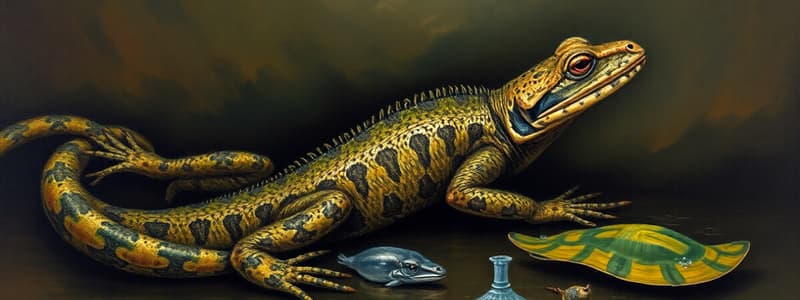Podcast
Questions and Answers
Which vertebrate class primarily uses gills for respiration?
Which vertebrate class primarily uses gills for respiration?
- Amphibians
- Reptiles
- Fishes (correct)
- Birds
What type of body covering do mammals possess?
What type of body covering do mammals possess?
- Feathers
- Moist skin
- Fur or hair (correct)
- Scales
Which vertebrate class is known to be cold-blooded?
Which vertebrate class is known to be cold-blooded?
- Mammals
- Amphibians (correct)
- Birds
- Reptiles (correct)
Which class of vertebrates can be found in both water and on land?
Which class of vertebrates can be found in both water and on land?
What is a common feature of birds regarding their locomotion?
What is a common feature of birds regarding their locomotion?
Flashcards
Fish Habitat
Fish Habitat
Fishes live primarily in water.
Amphibian Respiration
Amphibian Respiration
Amphibians breathe through lungs and skin.
Reptile Body Covering
Reptile Body Covering
Reptiles have tough and dry skin.
Bird Locomotion
Bird Locomotion
Signup and view all the flashcards
Mammal Body Temperature
Mammal Body Temperature
Signup and view all the flashcards
Study Notes
Vertebrate Classes Comparison
-
Fish:
- Habitat: Aquatic (water)
- Movement: Swimming
- Respiration: Gills
- Covering: Scales
- Body temperature: Varies with environment
- Reproduction and development: Varies
-
Amphibians:
- Habitat: Aquatic and terrestrial (land and water)
- Movement: Swimming, walking, jumping
- Respiration: Gills (larval stage), lungs (adult stage)
- Covering: Smooth skin
- Body temperature: Varies with environment
- Reproduction and development: Larval stage in water, metamorphosis to land-dwelling adult
-
Reptiles:
- Habitat: Primarily terrestrial (land)
- Movement: Crawling, slithering, swimming
- Respiration: Lungs
- Covering: Dry, scaly skin
- Body temperature: Varies with environment
- Reproduction and development: Lay eggs
-
Birds:
- Habitat: Terrestrial and aerial (land and air)
- Movement: Flying, walking, swimming
- Respiration: Lungs
- Covering: Feathers
- Body temperature: Constant (endothermic)
- Reproduction and development: Lay eggs
-
Mammals:
- Habitat: Terrestrial, aquatic, aerial
- Movement: Varies widely
- Respiration: Lungs
- Covering: Hair/fur
- Body temperature: Constant (endothermic)
- Reproduction and development: Give birth to live young
Studying That Suits You
Use AI to generate personalized quizzes and flashcards to suit your learning preferences.




